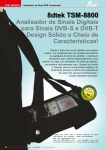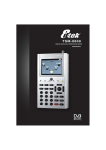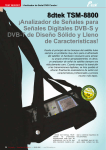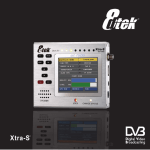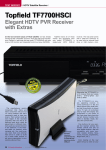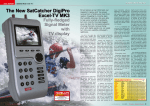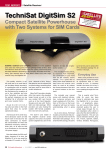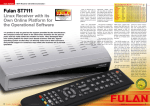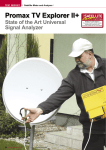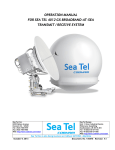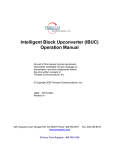Download 8dtek TSM-8800
Transcript
TEST REPORT DVB Combo Signal Analyzer 8dtek TSM-8800 Digital Signal Analyzer for DVB-S and DVB-T Signals Solid Design and Fully Featured! Since the beginning of the satellite age there was always this one problem for the die-hard satellite hobbyist: the necessary hardware to properly align his own antenna, that is, a satellite signal analyzer was always ridiculously expensive. When the transition to digital transmissions began, it finally became possible to offer signal analyzers with professional features at much lower prices. 0.6 26 TELE-satellite — Global Digital TV Magazine — 04-05/2010 — www.TELE-satellite.com Since that time, TELE-satellite has regularly presented these kinds of analyzers as long as they met our quality and functionality requirements. One such candidate, that without a doubt fulfills both of our demands, is the TSM-8800 from 8dtek. 8dtek from Hongkong was founded in 2008 and specializes in sophisticated, highly technical solutions. The TSM-8800 is a perfect example of that. analyzer can be placed in a safe spot in view of the installer and while the antenna or LNB is being adjusted, the signal analyzer can be operated using the credit-card sized remote control. For one thing, this helps to prevent the installer from accidentally dropping the analyzer to the ground while trying to adjust the antenna plus it’s simply much easier this way to control all the functions of the analyzer using a mini remote 04-05/2010 8dtek TSM -880 0 Easy menu operation and exc eptionally simple to operate When we opened up the box, it was obvious that 8dtek did not skimp on quality nor on any of the included accessories. Absolutely solid and sturdy; there’s no other way to describe it. The electronics were placed in a solid, brushed aluminum chassis. The analyzer itself sits nicely in your hand and is protected from falls and other environmental concerns. The manufacturer also surrounded the analyzer in a rubber jacket with openings for connectors on the underside as well as the upper and lower edges. This rubber jacket prevents the analyzer from slipping on almost any surface. Because of its relatively heavy weight, it sits solidly in place and thus makes it all the more easier to use. The front panel sports a 3.5inch LCD display. It’s very easy to read and produces very little glare even with direct sunlight. Six LEDs are located just below the display and indicate the current operational mode of the analyzer. At one glance you can identify the current polarization level as well as the current band (high or low) and whether or not the analyzer has locked on to a signal. 8dtek incorporated an infrared receiver right in the middle of the row of LEDs. Wait a minute… an infrared receiver for a signal analyzer? Actually, it’s not a bad idea! The signal www.TELE-satellite.com — 04-05/2010 — TELE-satellite — Global Digital TV Magazine 27 www.TELE-satellite.com/... TELE-satellite World Download this report in other languages from the Internet: control. And should you ever need both hands for whatever reason, the remote control can be easily slipped into your pocket. the other end for the PC has a serial connector, something you might not find anymore on every new PC or laptop. The signal analyzer itself comes with 15 function buttons, a cross-shaped button as well as a set of buttons labeled 0 to 9. All of these buttons except for the two on/off buttons can also be found on the remote control making it possible to completely control the TSM-8800 from a distance. The wide assortment of accessories includes a matching plug-in power supply, a car power adapter, an A/V cable, a useful carrying case that also helps to protect the unit plus a key chain with integrated compass. As you can see, 8dtek really thought of everything that an installer might need to set up a satellite antenna. The TSM-8800 also comes with every possible connector you could ever need. In addition to the satellite IF input and the integrated speaker, you will find RCA A/V outputs and A/V inputs on the underside of the unit. A printed user manual was not included in our test analyzer; it was provided by the manufacturer in PDF format in English, German, French and Spanish. A printed manual will though be provided with regular shipments. Connection to a PC can be done through the USB interface and the included USB/ serial adapter. This will let you not only upload new operating software but also let you edit the various settings and parameters directly on the PC. The only drawback is that the interface cable comes with a USB connector on one end to link with the analyzer while Up until now, we haven’t seen a signal analyzer with such easy-to-follow on-screen graphics and with functions so good and easy to use that anyone that has some idea of what’s going on can use this analyzer without having to refer to a user manual. Our compliments to the software programmers. The integrated lithium-ion Arabic Indonesian Bulgarian Czech German English Spanish Farsi French Hebrew Greek Croatian Italian Hungarian Mandarin Dutch Polish Portuguese Romanian Russian Swedish Turkish العربية Indonesia Български Česky Deutsch English Español فارس ي Français עברית Ελληνικά Hrvatski Italiano Magyar 中文 Nederlands Polski Português Românesc Русский Svenska Türkçe www.TELE-satellite.com/TELE-satellite-1005/ara/8dtek.pdf www.TELE-satellite.com/TELE-satellite-1005/bid/8dtek.pdf www.TELE-satellite.com/TELE-satellite-1005/bul/8dtek.pdf www.TELE-satellite.com/TELE-satellite-1005/ces/8dtek.pdf www.TELE-satellite.com/TELE-satellite-1005/deu/8dtek.pdf www.TELE-satellite.com/TELE-satellite-1005/eng/8dtek.pdf www.TELE-satellite.com/TELE-satellite-1005/esp/8dtek.pdf www.TELE-satellite.com/TELE-satellite-1005/far/8dtek.pdf www.TELE-satellite.com/TELE-satellite-1005/fra/8dtek.pdf www.TELE-satellite.com/TELE-satellite-1005/heb/8dtek.pdf www.TELE-satellite.com/TELE-satellite-1005/hel/8dtek.pdf www.TELE-satellite.com/TELE-satellite-1005/hrv/8dtek.pdf www.TELE-satellite.com/TELE-satellite-1005/ita/8dtek.pdf www.TELE-satellite.com/TELE-satellite-1005/mag/8dtek.pdf www.TELE-satellite.com/TELE-satellite-1005/man/8dtek.pdf www.TELE-satellite.com/TELE-satellite-1005/ned/8dtek.pdf www.TELE-satellite.com/TELE-satellite-1005/pol/8dtek.pdf www.TELE-satellite.com/TELE-satellite-1005/por/8dtek.pdf www.TELE-satellite.com/TELE-satellite-1005/rom/8dtek.pdf www.TELE-satellite.com/TELE-satellite-1005/rus/8dtek.pdf www.TELE-satellite.com/TELE-satellite-1005/sve/8dtek.pdf www.TELE-satellite.com/TELE-satellite-1005/tur/8dtek.pdf Available online starting from 2 April 2010 battery lets you use the analyzer continuously for four hours when fully charged. This should be enough to set up and align even the most complicated motorized antenna without having to worry about the battery dying. To put it all together, it’s safe to say that 8dtek has not only developed one of the highest quality signal analyzers that we have ever had the opportunity to test but 28 TELE-satellite — Global Digital TV Magazine — 04-05/2010 — www.TELE-satellite.com also from a handling and OSD point of view it certainly ranks as one of the best we have ever seen. Everyday Use After turning on the analyzer for the first time, the TSM8800 immediately jumps to the Main Menu. There is no Installation Assistant and it’s not even necessary. The submenu “System” lets you take care of all the necessary analyzer settings. The first would be to select the desired OSD language; you can choose from English, Russian, Dutch, French, Greek, Turkish, German, Czech, Spanish, Italian and Polish. You can also select where the analyzer will be used; 8dtek Logo The TSM-88008 Main Menu The System Settings menu lets you match the analyzer to your personal requirements Various LOF values are preprogrammed Zoom View makes it easier to read the value The preprogrammed satellite list comes with 61 entries The Blind Scan feature can find transponders that are not already in the preprogrammed list Real Time and Multi Functional DVB-S Spectrum NIT Mode Spectrum lets you identify the satellite clearly USALS Settings DiSEqC 1.0, 1.1, 1.2 and 1.3 (USALS) are supported Thanks to the PC editor, transponder and satellite data can easily be edited 30 TELE-satellite — Global Digital TV Magazine — 04-05/2010 — www.TELE-satellite.com The Angle calculation simplifies the installation of an antenna All identified and unencrypted channels can be viewed on the display The channel list contains all the TV and radio channels that were found The serial interface links the analyzer with a PC The channel list can also be matched to your personal preferences here you can choose from er’s many different settings probably England, capabilities. heads right now consider- France, Spain, Italy or Germany. Additional scratching their ing that we’re using a three- languages Since we are dealing with meter antenna but here in are being worked on and a Combi unit, the TSM-8800 Austria an antenna this size will be made available with comes with two different is absolutely a future software update. operational modes: DVB-S for the and DVB-T. We decided to of ASTRA 2D since we’re start our tests in DVB-S already quite a distance countries and An audible signal tone can also be activated here and the analyzer can be set to automatically shut off after a user-settable time period. The mode; we’ll get to DVB-T a little later. DVB-S After OSD also comes determining stable necessary reception outside of this satellite’s footprint. Regardless of how big that this analyzer is really easy or small the antenna actually is, it is essential to first to use and self-explanatory, figure out the correct satel- feature we decided to jump right lite parameters, that is, azi- that is user-settable. And into the deep end of the muth and elevation. of course, if it’s neces- pool and align our three- sary, the analyzer can be with a timeout meter antenna located in Normally, you’d have to easily returned to its fac- Vienna, Austria to ASTRA find some sort of table with tory settings thus giving 2D. this information or find it us an overall very positive impression of this analyz- online using a number of Our British readers are different Internet sites, but www.TELE-satellite.com — 04-05/2010 — TELE-satellite — Global Digital TV Magazine 31 All DVB-T channels can be searched none of this is necessary with the TSM-8800. The analyzer comes with its own Angle Calculation submenu that takes care of this work for you. To perform this calculation properly, you need to know the exact geographical position of the antenna as well as what satellite you want to align to. The geographical coordinates can easily be found via the Internet, for example, through Google Maps, Google Earth or Wikipedia. GPS navigation devices will also give you your local coordinates. Once the local latitude and longitude have been entered, the next step involves selecting the desired satellite. Now the user for the first time gets to see the preprogrammed satellite list stored in the analyzer and it is quite a list. 61 satellites with up-to-date transponder data are stored in memory. Multi Channel Search for DVB-T lets you view 8 channels Signal Quality simultaneously This makes working with the analyzer fun and with the push of just one button the azimuth and elevation data needed to adjust the antenna have been calculated for you. As soon as these values have been transferred to the antenna, the analyzer is switched over to DVB-S mode and the desired satellite is selected. The TSM-8800 assumes that it will be a Kuband satellite using a universal LNB. If this is not the case, the necessary parameters can be edited in the Scan menu. A number of LOF frequencies for the Ku-band and C-band are already preprogrammed but if needed the user can enter LOF values manually for those older LNBs with unusual LOFs. For every stored satellite entry there are multiple preprogrammed transponder entries available making it easy Active frequencies can easily be recognized in the spectrum analyzer display to activate and test them. Of course, if you want to, you can enter the required frequency manually which then automatically becomes part of the transponder list for the current satellite. Additional parameters such as low or high band as well as the LNB supply voltage which determines the polarization can be handled via the corresponding menu entries, via the function buttons on the analyzer or via the remote control. At the bottom of the screen are a pair if bar graphs that show the current signal strength and signal quality. With the help of one of the function buttons you can switch to a rough measurement of the antenna on an expanded display that shows noise offset, signal quality and signal level optically in bar graph form and also numerically. Additionally, there are also numerical values for VBER, CBER, the C/N as well as the channel power. 32 TELE-satellite — Global Digital TV Magazine — 04-05/2010 — www.TELE-satellite.com An acoustical signal output is available so that you can adjust the antenna without having to look at the analyzer. For our setup, we quickly adjusted the antenna to the correct angle and then began moving the dish in the direction of ASTRA 2D at 28.2° east. With such a large antenna, the signal level would naturally be relatively high and in no time at all the LOCK LED on the analyzer indicated a signal had been found. In Zoom mode we roughly aligned the antenna to ASTRA 2 but we already knew that the signals from the other ASTRA 2 satellites would be quite strong using a three-meter antenna and that receiving the signals from the ASTRA 2D bird would be the cream of the crop. So we switched over to normal scan mode and modified the preprogrammed fre- quency to one from ASTRA 2D. With the aid of the zoomed-in view, we began adjusting the antenna again. The goal was to achieve the highest signal quality while keeping the CBER to a minimum. Thanks to the screen-filling signal level display and the nearly instantaneous measurement response of the analyzer, we were able to do this easily and without any problems. Once the antenna was properly aligned we knew that we were pointing to ASTRA 2 but it would also be very practical to be able to display the received signals on the analyzer’s monitor. With the TSM-8800 this isn’t a problem at all, a variety of scan modes are available including TP scan, TP-NIT, satellite scan and Blind Scan at 8 MHz intervals and also at 12 MHz intervals. Yes, believe it or not, this signal analyzer comes with a Blind Scan mode that even worked perfectly in our tests! It scans the 950 to 2150 MHz frequency range in steps of either 8 or 12 MHz. It does take time to complete a scan (in our test a scan in 8 MHz steps on ASTRA 2 took 11 minutes) but it finds everything for you including some unknown transponders. If you don’t need to use Blind Scan, 8dtek incorporated a very fast transponder scan that looks at the currently selected transponder. It is also possible to perform an NIT transponder scan so that other transponders belonging to the same provider can be found as well. The satellite scan looks at all the preprogrammed transponders for the selected satellite. But since there are only a few transponders stored for each satellite, this scan is not nearly as complete compared to a standard satellite receiver. When dealing with more complex or motorized system installations, it is especially critical that the signal analyzer used be able to communicate with every possible DiSEqC component. The TSM-8800 can handle this without any problems; it comes integrated with DiSEqC 1.0 for up to four satellites, DiSEqC 1.1 for up to 16 satellites as well as DiSEqC 1.2 and 1.3 (USALS) for motorized systems. Aligning a USALS motorized system with the 8dtek analyzer is actually fun. After entering in your local geographical position the antenna can be moved to every desired satellite position. This makes it easy to identify an antenna that is not properly aligned or one with a mast that isn’t perfectly vertical letting you correct the problem with very little effort. To round it all off, the TSM8800 comes with a very clever channel list editor that lets you easily move, rename or delete any of the channels in the list. The channel list can therefore always be kept in an organized fashion. For the installer, the TSM-8800 couldn’t be better; he can store the most popular satellite positions and channels so that they can easily be shown to a customer. Another very practical feature is the integrated spectrum analyzer. It has the advantage of not only graphically displaying the entire frequency spectrum but it also makes it easy to align the antenna to a specific satellite or to look for a certain transponder. If you regularly install satellite systems, it won’t take long for you to look at the spectrum image of a satellite and be able to tell which satellite it is. But if you haven’t quite mastered the spectrum images just yet, the TSM-8800 can identify the satellite you’re currently pointed to using the NIT data from a valid transponder. 34 TELE-satellite — Global Digital TV Magazine — 04-05/2010 — www.TELE-satellite.com The spectrum analyzer can also highlight the peak that was reached by a particular signal; it displays a small symbol to indicate how high the most recent signal peak was. This feature lets you use the spectrum analyzer as a way to initially fine tune the antenna assembly. The TSM-8800 can display the entire frequency spectrum or you can zoom in on a specific section and then use a cursor to mark each signal peak so that it can be directly read in to the analyzer. It’s becoming clear that the TSM-8800 would not only be a useful tool for installers but it would also be very interesting for DXers and feedhunters. With just one look an experienced feed hunter would be able to recognize which feed frequencies are currently active and with the push of just one button the desired transponders would be identified followed by a full-screen display of the feed on the analyzer. As soon as an active transponder has been identified, the new 8dtek analyzer immediately blends in additional information such as noise offset, C/N, various signal quality values as well as the orbital position of the current satellite. To document all the work that has been done, the spectrum image on the analyzer can be stored and later recalled if needed. DVB-T The signal scanning and processing with DVB-T is similar to DVB-S although the reception parameters for DVB-T are less plus DVB-T uses a different frequency range. The desired DVB-T frequency can be entered manually or it can selected from the preprogrammed list. The TSM-8800 can also supply the necessary power for an external signal amplifier directly through the coax cable the parameters of which can be edited in the channel scan menu. As soon as a signal is found, the display shows the signal quality and signal level bar graphs just like in DVB-S mode. A channel scan can be performed on a specific transponder or it can be done on the entire frequency spectrum. Naturally DVB-T mode also comes with a zoom view with expanded signal bar graphs as well as the display of S/N and BER in numerical form. The analyzer also provides information on the FEC and modulation mode that is being used. A very practical feature is the ability to show the signal levels from up to eight different frequencies at the same time. This makes it easy to adjust the antenna so that the highest possible signal level can be reached on all of the frequencies; it’s an especially important feature when dealing with multiple frequencies from different broadcasters using one antenna. And just like in DVB-S mode, DVB-T signals can be identified and viewed on the analyzer’s screen. Another amazing bonus feature is that TSM-8800 can indicate MPEG4 SD and HD channels, although it is not able to display those channels yet. ENERGY DIAGRAM Apparent Power Mode Apparent Active Factor Battery Loading 45 W 27 W 0.6 Finally, we wanted to check out the three RCA jacks on the underside of the analyzer a little more closely. Active Power While the A/V jacks displayed video that was helpful to us for this test report, the end user would probably not use them all too much since even with the remote control, the analyzer is not a comfortable DVB receiver. + The TSM-8800 is a handy and reliable analyzer for digital DVB-S and DVB-T signals. It is controlled by a very logical and user-friendly constructed on-screen display and is shipped from the factory with very up-to-date preprogrammed Thomas Haring TELE-satellite data. Test Center Austria Thanks to the many different settings capabilities and features, it is easy to adjust any antenna system. The spectrum analyzer mode makes it easy to find active frequencies and is perfect for DXers and feedhunters. The assortment of accessories as well as the excellent user manual clearly show that the manufacturer always keeps the customer in mind. On the other hand, the video input is very practical; it can be used for example while installing larger, motorized antennas that are moved using 36-volt actuators. The video from the required positioner can be attached here. You can also use this input to display any other CVBS signal on the analyzer. Thanks to the integrated interface to a PC, the analyzer’s software can easily be updated and since 8dtek is constantly working on improving their products, they would consistently use this function in order to add more features to their products. The transponder and satellite lists can also be edited on a PC and in our tests this turned out to be no problem at all using an MS Windows PC. Unfortunately you need a serial interface for this to work, something you might not find on newer PCs or laptops. Overall though we were quite thrilled with the TSM-8800. We can’t wait to see what technological advances will come but one thing about digital TV reception and its accessories is very clear: the competition will definitely have their hands full! Expert Opinion - The interface to a PC should be via USB TECHNICAL DATA Distributor 8dtek Technology, Hongkong Email [email protected] Website www.8dtek.com Model TSM-8800 Function DVB Signal Meter with tv monitor for DVB-S and DVB-T Display 3.5“ LCD color display Frequency range 950~2150 MHz (DVB-S) and UHF/VHF (DVB-T) Level range -65 dBm ~ -25 dBm (DVB-S) and -78 ~ -20 dBm (DVB-T) LNB power supply 13/18V, max. 500 mA Symbol rate 2~45 Ms/s DiSEqC Yes (1.0, 1.1, 1.2 and 1.3 (USALS)) Spectral Inversion Auto conversion Video format 720x576 (PAL), 720x480 (NTSC) & SECAM Supply voltage 13.3V Supply voltage charger 90-240V Li-oN battery 2200 mA Supplied items Protective case, user guide, mains charging unit, car charger, PC connection cable, A/V cable Dimension 10.2 x 18 x 3.4 cm Net weight 0.72kg www.TELE-satellite.com — 04-05/2010 — TELE-satellite — Global Digital TV Magazine 35








